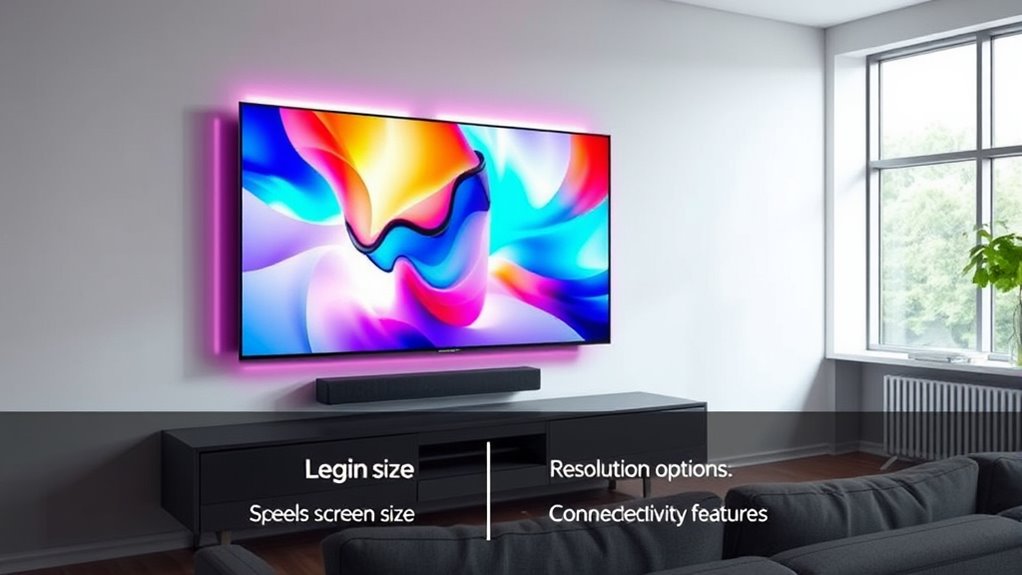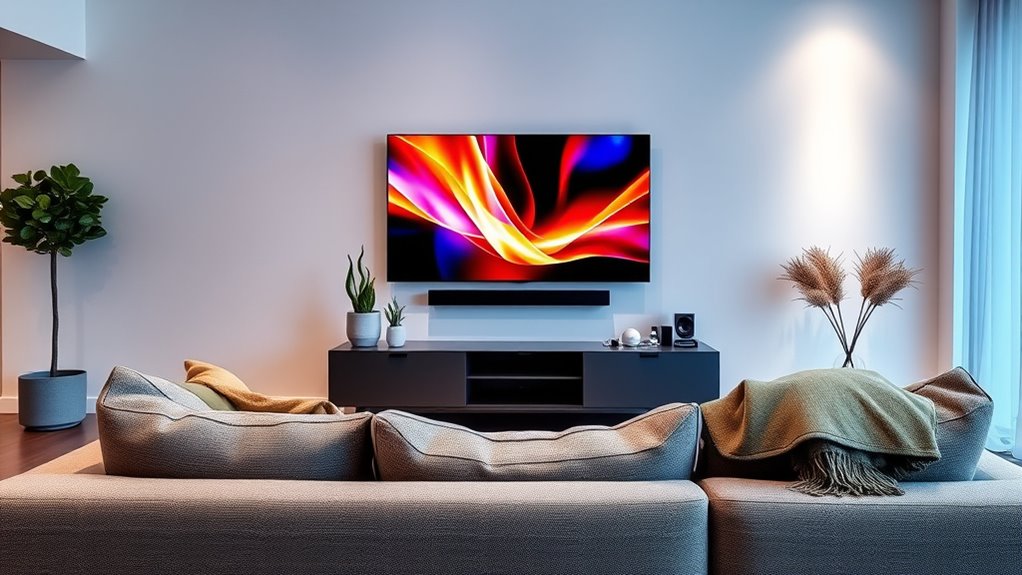When choosing a smart TV for your living room, consider the display technology like OLED for better contrast or QLED for vibrant colors, depending on your environment. Check the resolution; while 4K is standard, 8K offers more detail if your budget permits. Look for higher refresh rates if you watch sports or game, and verify the TV supports HDR and a wide color gamut for vivid images. Smart features like voice control and app compatibility are essential, and good sound often means adding a soundbar. Keep exploring to find the perfect match.
Key Takeaways
- Choose the right display technology (OLED, QLED, LED) based on your room lighting and picture quality preferences.
- Consider resolution (4K, 8K) and budget, balancing content availability and future-proofing.
- Evaluate refresh rates (60Hz, 120Hz) and response times for smooth motion in sports, movies, or gaming.
- Check HDR support and color gamut for vibrant visuals, especially with local dimming for better contrast.
- Ensure smart features like app compatibility, voice control, HDMI ports, and sound options meet your entertainment needs.

Buying a smart TV can seem overwhelming with so many options available, but understanding the key features can help you make an informed choice. First, consider the type of display technology that best suits your needs. OLED TVs deliver exceptional contrast and color accuracy, making them perfect for cinematic experiences and gaming. QLED TVs also offer vibrant colors and high brightness, especially useful if your living room is well-lit. If budget is a concern, LED TVs provide good performance at a more affordable price. For improved brightness and local dimming, Mini-LED models are a solid upgrade, giving you better contrast and picture quality.
Next, think about resolution. If you’re after crisp, detailed images, 4K Ultra HD is the standard for most modern TVs and works well with larger screens and streaming platforms. If you’re a tech enthusiast or want the best possible clarity, 8K Ultra HD offers the highest resolution, but keep in mind that content is limited, and these models tend to be more expensive. For smaller rooms or budget-friendly options, 2K (Full HD) still provides decent picture quality. Also, factor in the cost, as higher resolutions often come with a higher price tag.
4K is the standard, 8K offers top detail but at a higher cost, and 2K (Full HD) is budget-friendly.
Refresh rates and motion handling are vital if you watch a lot of fast-paced sports, action movies, or play games. A 60Hz refresh rate is fine for general viewing, but for smoother motion, especially in gaming, look for models with 120Hz or 240Hz. Motion interpolation can improve clarity but sometimes creates an unnatural “soap opera” effect. Response time affects how quickly pixels change, reducing blur during quick movements, which is important for gaming.
HDR support enhances contrast and color, making images more vibrant and realistic. Look for TVs that support HDR10, Dolby Vision, or HDR10+ for the best quality. A wide color gamut, like DCI-P3, ensures vibrant, accurate colors. Local dimming improves contrast by adjusting brightness in different parts of the screen, and OLED TVs excel here with superior color accuracy and contrast. Additionally, content availability plays a crucial role in maximizing your smart TV experience, so check whether your favorite streaming services are supported.
Smart features are a key part of modern TVs. Make sure the TV has popular streaming apps like Netflix and Prime Video. Voice control compatibility with Alexa or Google Assistant adds convenience, and smart home integration can streamline your tech setup. Multiple HDMI ports, preferably with eARC, let you connect gaming consoles, soundbars, and other devices easily. Wireless options like Wi-Fi and Bluetooth make setup simple and allow for streaming content or connecting peripherals.
Finally, consider sound quality. Built-in speakers are standard, but adding a soundbar can dramatically improve audio. Look for support for Dolby Atmos or DTS:X for immersive sound, and check for various audio outputs to connect external audio devices. Investing in a TV with well-rounded features ensures a seamless, enjoyable entertainment experience tailored to your living room.
Frequently Asked Questions
How Do I Ensure My Smart TV Is Compatible With Existing Devices?
To guarantee your smart TV works seamlessly with your existing devices, first check its OS compatibility with your streaming devices like Chromecast or Roku. Make sure it supports HDCP for streaming, has enough HDMI and USB ports, and offers strong Wi-Fi or Ethernet connections. Verify compatibility with your preferred streaming apps, voice assistants, and content formats. This way, your setup stays smooth and future-proof.
What Are the Best Privacy Features to Look for in a Smart TV?
Imagine your smart TV as a fortress guarding your privacy. Look for features like customizable data sharing, privacy modes, and clear, transparent policies. Seek encryption for stored data and options to disable data collection or location services. Prioritize brands with a solid privacy reputation, and guarantee easy access to privacy settings. These features act like a shield, keeping your personal information safe amid the digital storm.
How Often Should I Update My Smart Tv’S Firmware?
You should update your smart TV’s firmware whenever updates are available, ideally allowing automatic updates to run in the background. Regularly check for manual updates if automatic ones aren’t enabled. Staying current ensures your TV remains compatible with apps, performs at its best, and stays secure. Don’t wait too long—delaying updates can cause performance issues, security risks, and compatibility problems, so make it a routine part of your maintenance.
Can I Connect My Smart TV to a Sound System Easily?
Imagine a seamless flow of crisp sound from your TV to your sound system, like a gentle breeze carrying music across a room. Connecting your smart TV is straightforward: identify matching ports, choose HDMI ARC or optical cables, and plug them in. Just guarantee your devices support the same connection type, then adjust the settings. Wireless options like Bluetooth make it even easier, turning setup into a simple, hassle-free experience.
What Are the Energy Consumption Considerations for Smart TVS?
When thinking about energy consumption for smart TVs, you should consider factors like screen size, display type, and usage patterns. Larger screens and older technologies like plasma tend to use more energy, while LED and OLED models are more efficient. Also, using eco-settings, turning off the TV when not in use, and choosing ENERGY STAR-certified models can help you save energy and reduce your electricity bills.
Conclusion
Now that you know what to look for, your perfect smart TV is just a few steps away. Consider size, features, and budget, and you’ll transform your living room into a cinematic paradise. Don’t settle for anything less than extraordinary — your new TV will be the centerpiece of entertainment for years to come. Get ready to binge, stream, and enjoy every moment with a device that’s as smart as it is stunning. Happy shopping!










